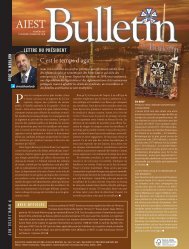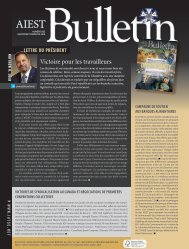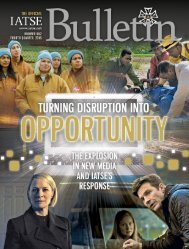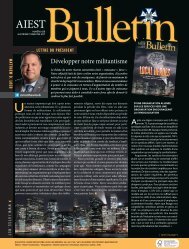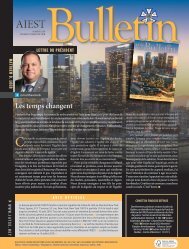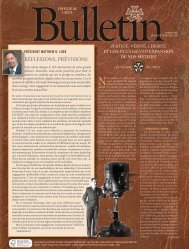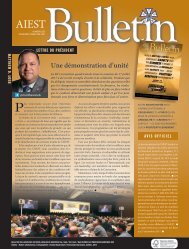The Official Bulletin - Quarter 2, 2019
- No tags were found...
You also want an ePaper? Increase the reach of your titles
YUMPU automatically turns print PDFs into web optimized ePapers that Google loves.
the equipment manufacturers. <strong>The</strong>y’re providing<br />
technology at the request of the client. But<br />
then you have to add in the reality part. A lot<br />
of people would rather push the envelope of<br />
what is possible for one person to do. <strong>The</strong>y’ve<br />
done such a good job with this technology, it’s<br />
almost seamless and that’s the scary part for<br />
the technician.”<br />
One consequence of the explosion of video and audio data<br />
that can be obtained, transmitted and played back at the speed<br />
of light is that some sports networks have established remote<br />
hubs to produce their broadcasts. Rather than sending a truck<br />
to each event covered, they establish central control rooms —<br />
also called bunkers — in one location to handle multiple broadcasts.<br />
In some cases, broadcasters have placed these bunkers<br />
outside the geographic jurisdiction of IATSE contracts and attempted<br />
to staff them on a non-union basis.<br />
“When I work the trucks, our collective bargaining agreement<br />
specifies the number of camera inputs I handle and<br />
matches the wage to the job requirements,” Colwell said.<br />
“None of these standards apply in non-union bunkers. But that<br />
creates organizing opportunities.”<br />
Colwell was a lead organizer in Local 762’s successful<br />
campaign to win representation for technicians at the Big 10<br />
Network’s hub, known as MICR (Multi-Insert Camera Remote).<br />
<strong>The</strong> workers are now in the process of bargaining their first<br />
contract. “My goal with organizing is open and straightforward,”<br />
he said. “If it’s going to help you, you’ll vote yes. If not, you’ll<br />
vote no. And everybody gets to make that decision — that’s<br />
the wonderful thing about democracy. You supply people with<br />
information and you leave it there. <strong>The</strong>y get to decide.”<br />
Another technological advance in broadcasting — albeit<br />
one with fewer downsides to IATSE members’ work demands<br />
— is the growing use of robotic cameras placed in strategic<br />
locations, such as on top of a basketball backboard, in the<br />
corner of a soccer goal, or flying on cables above a football<br />
field, all placing viewers closer to the action than ever before.<br />
“You can be in a truck or located by the camera to operate<br />
it,” said Jesse Madison, a past Executive Board Member<br />
of Local 745 in Minneapolis and robotic camera operator. “It<br />
depends on the space available. <strong>The</strong>y’re so versatile. You can<br />
put control panels in many different places and you move the<br />
camera with a joystick. Today, there’s usually one or two for a<br />
regional broadcast, and more for national broadcast. <strong>The</strong> idea<br />
is to get the lens as close to the action as possible.”<br />
Perhaps the biggest breakthrough is the application of virtual<br />
reality technology to create 360 degree, three-dimensional<br />
stop animation. “You place cameras all the way around the field<br />
all working in unison, treating the field as a 3-D box,” he explained.<br />
“In a football game, you can start the play right behind<br />
the quarterback, seeing what he sees as he looks downfield.<br />
<strong>The</strong>n just as he throws, you freeze frame it and the perspective<br />
circles around to the opposite side of the field. <strong>The</strong>n you<br />
hit play again and see it continue from a completely different<br />
vantage point.”<br />
This same technology is already being used for virtual reality<br />
applications, placing the viewer right in the middle of the<br />
action. “You set up virtual reality cameras on the baskets and<br />
up against the court,” Madison said. “<strong>The</strong>re are six lenses and<br />
six cameras in one unit. A video operator is correcting images<br />
in real time and stitching them together so you don’t see any<br />
seams. <strong>The</strong> viewer puts VR goggles on and is right at courtside<br />
with a 360 degree views no matter which way he or she turns.”<br />
Tying all of this together, both literally and figuratively, is<br />
another technological revolution: <strong>The</strong> rise and ubiquity of fiber<br />
optic cables. “<strong>The</strong> bandwidth required to transmit an HDTV<br />
digital signal — especially one capable of producing super<br />
slow motion or from a 4K camera — is far greater than traditional<br />
copper wire can handle,” O’Hern said. “You need fiber<br />
optic cable, but this is a completely different beast requiring<br />
very different care and handling. And it’s needed for audio, too.<br />
For example, to broadcast a game at Wrigley field, you have<br />
the announcers’ booth with five microphones, two mics in each<br />
dugout for interviews, and multiple mics around the stadium<br />
to capture the sounds of game. What used to take multiple<br />
cables with multiple feeds can now be handled by two or three<br />
fiber optic cables, which are much lighter and easier to handle<br />
but take a lot more maintenance.<br />
“That’s why the Broadcast Department developed a fiber<br />
optics training course,” O’Hern explained. “And since this technology<br />
is being used not only in broadcast but also in our other<br />
crafts, whenever we offer training in a city, we try to partner<br />
SECOND QUARTER <strong>2019</strong> 27





